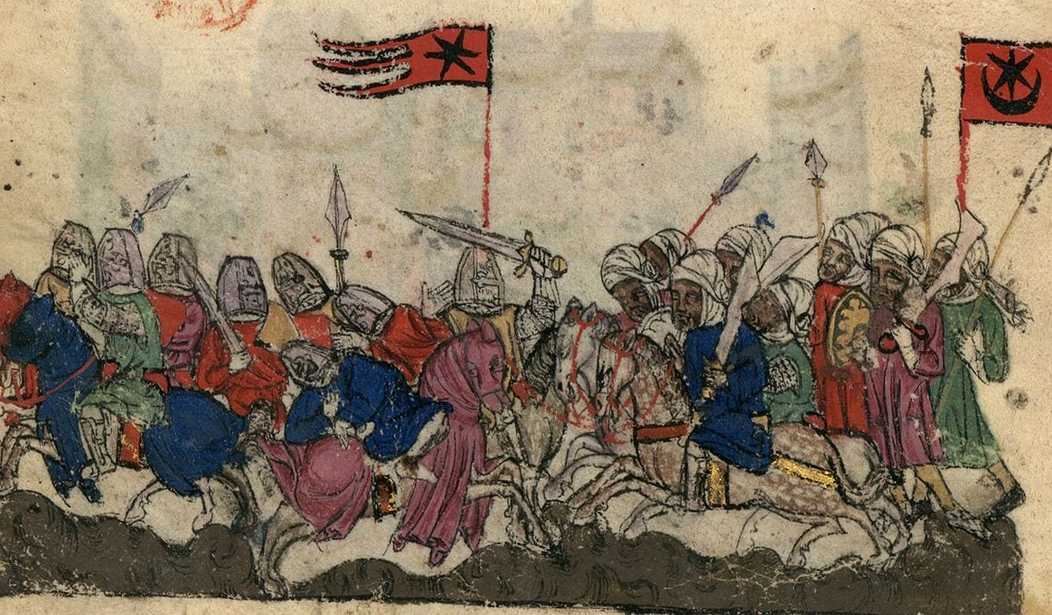Today in history, on August 20, 636, one of the most consequential battles between Islam and the West took place, the Battle of Yarmuk. Not only did it decide whether the Arabian creed thrives or dies; it became a chief source of inspiration and instruction for jihadis throughout the centuries, right down to the Islamic State, or “ISIS.”
And yet, very few in the West are even aware of this encounter’s existence—much less how it motivates ISIS. As such, and in what follows, a detailed examination is offered.
The story begins, perhaps unsurprisingly, with the prophet of Islam. Four years before the battle, in 632, Muhammad had died. During his lifetime, he had managed to rally the Arabs under the banner of Islam. On his death, some tribes that sought to break away remained Muslim but refused to pay taxes, or zakat, to the caliph, Abu Bakr, Muhammad’s successor. Branding them all apostates, the caliph initiated the Ridda (“apostasy”) Wars, which saw tens of thousands of Arabs beheaded, crucified, or burned alive. In 633, these wars were over; in 634, so was the life of Abu Bakr. It would fall to the second caliph, Omar bin al-Khattab (r. 634–44), to direct the full might of the once feuding Arabs — now one tribe, one umma — against “the infidel.”
Almost instantly, thousands of Arabs flooded into Christian Syria, slaughtering and pillaging. According to Muslim historians, this was done in the name of jihad — to spread Allah’s rule on earth. Emperor Heraclius, who had just experienced a decade of war against the Persians, proceeded to muster his legions and direct them to Syria, to quash these latest upstarts. Roman forces engaged the invaders in at least two significant battles, Ajnadayn (in modern-day Israel, in 634) and Marj al-Saffar (south of Damascus, 635). But “by Allah’s help,” writes Muslim chronicler al-Baladhuri (d. 892), “the enemies of Allah were routed and shattered into pieces, a great many being slaughtered.”
Heraclius had no intention of forsaking Syria, for centuries an integral part of the Roman Empire. He had recently recovered it from the Persians and was not about to abandon it to the despised Saracens, So, by spring 636, the emperor had managed to raise a large multiethnic army, recruited from all over Christendom, according to al-Waqidi (747–823), a Muslim chronicler and the author of Futuh al-Sham, the only detailed (though often suspect) account of the Arab conquest of Syria. (Unless otherwise indicated, all direct quotes that follow are from Futuh and translated by me.) Some 30,000 Christian fighters began their march south. Muslim forces, numbering approximately 24,000 — with women, slaves, children, camels, and tents in tow — withdrew from their recently conquered territories and congregated by the banks of the Yarmuk River in Syria. The landscape was dominated by two ravines, one along the Yarmuk and the other along the Wadi Ruqqad, each with a vertical drop of 100 to 200 feet — a deadly prospect for anyone fleeing in haste.
The Arabs dispatched a hurried message to Caliph Omar, complaining that “the dog of the Romans, Heraclius, has called on us all who bear the cross, and they have come against us like a swarm of locusts.” Given that “to see Christendom fall” was Omar’s “delight,” to quote from the Shahnameh, that “his meat was their humiliation,” and that “his very breathing was their destruction,” reinforcements were forthcoming.
Heraclius appointed Vahan, an Armenian and a hero of the Persian Wars, as supreme commander of his united forces. The supreme leader of the Arabs was Abu Ubaida, but Khalid bin al-Walid, whom Muhammad had dubbed the “Sword of Allah,” commanded thousands of horsemen and camel riders behind the infantry and influenced military decisions.
Before battle, Vahan and Khalid met under a flag of truce to negotiate. The Armenian commander began by diplomatically blaming Arabia’s harsh conditions and impoverished economy for giving the Arabs no choice but to raid Roman lands. Accordingly, the empire was pleased to provide them with food and coin on the condition that they return home. “It was not hunger that brought us here,” Khalid responded coolly, “but we Arabs are in the habit of drinking blood, and we are told the blood of the Romans is the sweetest of its kind, so we came to shed your blood and drink it.
Vahan’s diplomatic mask instantly dropped and he launched into a tirade against the insolent Arab: “So, we thought you came seeking what your brethren always sought” — plunder, extortion, or mercenary work. “But, alas, we were wrong. You came killing men, enslaving women, plundering wealth, destroying buildings, and seeking to drive us from our own lands.” Better people had tried to do the same but always ended up defeated, added Vahan in reference to the recent Persian Wars, before continuing:
As for you, there is no lower and more despicable people — wretched, impoverished Bedouins. . . . You commit injustices in your own nation and now ours. . . . What havoc you have created! You ride horses not your own and wear clothes not your own. You pleasure yourselves with the young white girls of Rome and enslave them. You eat food not your own, and fill your hands with gold, silver, and valuable goods [not your own]. Now we find you with all our possessions and the plunder you took from our coreligionists — and we leave it all to you, neither asking for its return nor rebuking you. All we ask is that you leave our lands. But if you refuse, we will annihilate you!
The Sword of Allah was not impressed. He began reciting the Koran and talking about one Muhammad. Vahan listened in quiet exasperation. Khalid proceeded to call on the Christian general to proclaim the shahada and thereby embrace Islam, in exchange for peace, adding: “You must also pray, pay zakat, perform hajj at the sacred house [in Mecca], wage jihad against those who refuse Allah, . . . befriend those who befriend Allah and oppose those who oppose Allah,” a reference to the divisive doctrine of al-wala’ wa al-bara’. “If you refuse, there can only be war between us. . . . And you will face men who love death as you love life.”
“Do what you like,” responded Vahan. “We will never forsake our religion or pay you jizya.” Negotiations were over.
Things came to a head, quite literally, when 8,000 marching Muslims appeared before the Roman camp carrying the severed heads of 4,000 Christians atop their spears. These were the remains of 5,000 reinforcements who had come from Amman to join the main army at Yarmuk. The Muslims had ambushed and slaughtered them. Then, as resounding cries of “Allahu akbar” filled the Muslim camp, those Muslims standing behind the remaining 1,000 Christian captives knocked them over and proceeded to carve off their heads before the eyes of their co-religionists, whom Arabic sources describe as looking on in “utter bewilderment.”
*****
So it would be war. On the eve of battle, writes historian A. I. Akram, “the Muslims spent the night in prayer and recitation of the Quran, and reminded each other of the two blessings that awaited them: either victory and life or martyrdom and paradise.”
No such titillation awaited the Christians. They were fighting for life, family, and faith. During his pre-battle speech, Vahan explained that “these Arabs who stand before you seek to . . . enslave your children and women.” Another general warned the men to fight hard or else the Arabs “shall conquer your lands and ravish your women.” Such fears were not unwarranted. Even as the Romans were kneeling in pre-battle prayer, Arab general Abu Sufyan was prancing on his war steed, waving his spear, and exhorting the Muslims to “jihad in the way of Allah,” so that they might seize the Christians’ “lands and cities, and enslave their children and women.”
The battle took place over the course of six days. (For a much more detailed examination of Yarmuk and its consequences, see my Master’s thesis, The Battle of Yarmuk: An Assessment of the Immediate Factors behind the Islamic Conquests, 2002.) The Roman forces initially broke through the Muslim lines and, according to colorful Muslim sources, would have routed the Arabs if not for their women. Prior to battle, Abu Sufyan had told these female Arabs that, although “the prophet said women are lacking in brains and religion” (a reference to a hadith), they could still help by striking “in the face with stones and tent poles” any Arab men who retreated from the battle to camp. The women were urged to persist until the men returned to battle “in shame.”
Sure enough, whenever broken ranks of Muslims fell back, Arab women hurled stones at them, struck them, and their horses and camels, with poles, taunting them: “May Allah curse those who run from the enemy! Do you wish to give us to the Christians? . . . If you do not kill, then you are not our men.” Abu Sufyan’s wife, Hind, is said to have fought the advancing Romans while screaming “Cut the extremities [i.e., phalluses] of the uncircumcised ones!” On witnessing her boldness, the Arab men are said to have turned and driven back the advancing Romans to their original position.
On the fourth day, the Muslims managed to reverse the tables and advance against a broken line of retreating Christians. No women were present to chastise the retreating Romans, and a multitude of archers unleashed volley after volley on the rushing Arabs. “The arrows rained down on the Muslims. . . . All one could hear was ‘Ah! My eye!’ In heavy confusion, they grabbed hold of their reins and retreated.” Some 700 Muslims lost an eye on that day.
Concerning the sixth and final day of battle, Muslim sources make much of the heavy infantry of the Roman army’s right flank, referring to its soldiers as the “mightiest.” These warriors reportedly tied themselves together with chains, as a show of determination, and swore by “Christ and the Cross” to fight to the last man. (The Arabs may have mistaken the remarkably tight Roman phalanx for fetters.) Even Khalid expressed concern at their show of determination. He ordered the Muslims at the center and left of the Arab army to bog down the Christians, while he led thousands of horsemen and camel-fighters round to the Roman left faction, which had become separated from its cavalry (possibly during an attempt at one of the complicated “mixed formation” maneuvers recommended in the Strategikon, a Byzantine military manual).
To make matters worse, a dust storm — something Arabs were accustomed to, their opponents less so — erupted around this time and caused mass chaos. The Romans’ large numbers proved counterproductive under such crowded and chaotic conditions. Now the fiercest and most desperate fighting of the war ensued. Everywhere, steel clashed, men yelled, horses neighed, camels bellowed, and sand blew in the face of the confused mass. Unable to maneuver, most of the Roman cavalry, carrying along a protesting Vahan, broke off and withdrew to the north.
Realizing that they were alone, the Christian infantry, including the “chained men,” maintained formation and withdrew westward, to the only space open to them. They were soon trapped between an Islamic hammer and anvil: A crescent of Arabs spreading from north to south continued closing in on them from the east, while a semicircle of the Wadi Ruqqad’s precipitous ravines lay before the Christians to the west. (Khalid had already captured the only bridge across the wadi.)
As darkness descended on this volatile corner of the world, the final phase of war played out on the evening of August 20. The Arabs, whose night vision was honed by desert life, charged the trapped Romans, who, according to al-Waqidi and other Muslim historians, fought valiantly. The historian Antonio Santosuosso writes that
soon the terrain echoed with the terrifying din of Muslim shouts and battle cries. Shadows suddenly changed into blades that penetrated flesh. The wind brought the cries of comrades as the enemy stealthily penetrated the ranks among the infernal noise of cymbals, drums, and battle cries. It must have been even more terrifying because they had not expected the Muslims to attack by dark.
Muslim cavalrymen continued pressing on the crowded and blinded Roman infantry, using the hooves and knees of their steeds to knock down the wearied fighters. Pushed finally to the edge of the ravine, rank after rank of the remaining forces of the imperial army, including all of the “chained men,” fell down the steep precipices to their death. Other soldiers knelt, uttered a prayer, made the sign of the cross, and waited for the onrushing Muslims to strike them down. No prisoners were taken on that day. “The Byzantine army, which Heraclius had spent a year of immense exertion to collect, had entirely ceased to exist,” writes British lieutenant-general and historian John Bagot Glubb. “There was no withdrawal, no rearguard action, no nucleus of survivors. There was nothing left.”
As the moon filled the night sky and the victors stripped the slain, cries of “Allahu akbar!” and “There is no god but Allah and Muhammad is his messenger” rang throughout the Yarmuk Valley.
*****
Following this decisive Muslim victory, the way was left wide open for the domino-like Arab conquests of the seventh century. “Such a revolution had never been,” remarks historian Hilaire Belloc. “No earlier attack had been so sudden, so violent, or so permanently successful. Within a score of years from the first assault in 634 [at the Battle of Ajnadayn], the Christian Levant had gone: Syria, the cradle of the Faith, and Egypt with Alexandria, the mighty Christian See.”
Without the power of hindsight afforded to historians living more than a millennium after the fact, even Anastasius of Sinai, who witnessed Muslim forces overrun his Egyptian homeland four years after Yarmuk, testified to the decisiveness of the battle by referring to it as “the first terrible and incurable fall of the Roman army.” “I am speaking of the bloodshed at Yarmuk, . . . after which occurred the capture and burning of the cities of Palestine, even Caesarea and Jerusalem. After the destruction of Egypt there followed the enslavement and incurable devastation of the Mediterranean lands and islands.”
Indeed, mere decades after Yarmuk, all ancient Christian lands between Greater Syria to the east and Mauretania (encompassing parts of present-day Algeria and Morocco) to the west — nearly 4,000 miles — had been conquered by Islam. Put differently: Two-thirds of Christendom’s original, older, and wealthier territory was permanently swallowed up by the scimitar of jihad. (Eventually, and thanks to the later Turks, “Muslim armies conquered three-quarters of the Christian world,” to quote historian Thomas Madden.)
But unlike the Germanic barbarians who invaded and conquered Europe in the preceding centuries, only to assimilate into the Christian religion, culture, and civilization and adopt its languages, Latin and Greek, the Arabs imposed their creed and language onto the conquered peoples so that, whereas the “Arabs” were once limited to the Arabian Peninsula, today the “Arab world” consists of some 22 nations across the Middle East and North Africa.
This would not be the case, and the world would have developed in a radically different way, had the Eastern Roman Empire defeated the invaders and sent them reeling back to Arabia. Little wonder that historians such as Francesco Gabrieli hold that “the battle of the Yarmuk had, without doubt, more important consequences than almost any other in all world history.”
It bears noting that if most Westerners today are ignorant of that encounter and its ramifications, they are even more oblivious as to how Yarmuk continues to serve as a model of inspiration for modern-day jihadis (who, we are regularly informed, are “psychotic criminals” who have “nothing to do with Islam”). As the alert reader may have noticed, the continuity between the words and deeds of the Islamic State (ISIS) and those of its predecessors from nearly 1,400 years ago are eerily similar. This, of course, is intentional. When ISIS proclaims that “American blood is best and we will taste it soon,” or “We love death as you love life,” or “We will break your crosses and enslave your women,” they are quoting verbatim — and thereby placing themselves in the footsteps of — Khalid bin al-Walid and his companions, the original Islamic conquerors of Syria.
Similarly, ISIS’s black flag is intentionally patterned after Khalid’s black flag. Its invocation of the houris, Islam’s celestial sex-slaves promised to martyrs, is based on anecdotes of Muslims dying by the Yarmuk River and being welcomed into paradise by the houris. And the choreographed ritual slaughter of “infidels,” most infamously of 21 Coptic Christians on the shores of Libya, is patterned after the ritual slaughter of 1,000 captured Roman soldiers on the eve of the Battle of Yarmuk.
Here, then, is a reminder that, when it comes to the military history of Islam and the West, the lessons imparted are far from academic and have relevance to this day — at least for, and understanding the mindset of, the jihadis.
Note: The above account is excerpted from Sword and Scimitar: Fourteen Centuries of War between Islam and the West — a book that CAIR and its Islamist allies did everything they could to prevent the U.S. Army War College from learning about.










Join the conversation as a VIP Member